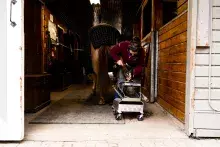
Kwantlen Polytechnic University has launched its newly redesigned farrier program.
Changes to the Certificate in Farrier Science include additional opportunities for students to gain more experience with horses in the field.
“The biggest difference is that we’ve incorporated 240 hours of practicum experience for students,” says Gerard Laverty, instructor of the Farrier Program.
“Half the class will be out in the field for six weeks in the early part of the program working with farriers. The whole idea of that is to give them a better understanding of what the field experience is like.”
The students will still work with horses in the farrier barn at KPU Tech in Cloverdale, Surrey, but changes to the program add a new dimension. Laverty says the barn is an artificial environment where everything is controlled and the pace isn’t the same.
“Out in the field, there are pressures that the farrier has that a student in the shop doesn’t have. One of them being that the horse is on their home territory and you have to accommodate that and the expectations of a client. There’s only so much time set aside to take care of the needs of the horse.”
Other changes to the program include the addition of a capstone course for students to demonstrate their mastery of the subject, says Brian Moukperian, dean in the Faculty of Trades and Technology.
“There is also an e-portfolio component and it is much more hands-on,” adds Moukperian. “The program will give students all the tools they need once they’re ready to graduate and work in the field.”
The farrier program is best suited to people who work on farms and ranches, or who are involved in horse recreation and competition. Students entering the program need experience with horses and must provide two letters of recommendation certifying that experience.
“So much of the work involves working with a horse and horses can be unpredictable and you’re in a dangerous position whenever you are underneath a horse so if something was to startle the animal, if you’re underneath you’re going to be in harm’s way,” says Laverty.
Along with horsemanship skills, Laverty says students have to master skills such as maintaining the horse’s hoof within a narrow window of tolerance and identifying the right type of shoe for the horse’s environment.
“So, the farrier has to have a plan in place to keep that horse operating at the level the client or owner has the horse for – jumping, running, chasing, or on a trail going for a ride,” he adds.
Farriers should be in good physical shape as they sit in awkward positions dealing with a very large animal. Creativity is also a factor as a farrier has to be able to look at a hoof and create a shoe out of hot steel by knowing exactly what shape the shoe should be without using many measuring tools.
Dr. Sandy Vanderburgh, KPU provost and vice president academic, adds that “Gerard, the dean, and numerous support staff, have all worked together to respond to feedback from industry to design a new and improved Farrier Science program that will produce industry-ready graduates”.
The Certificate in Farrier Science will have a class size of up to 12 students and begins October 26, 2020.